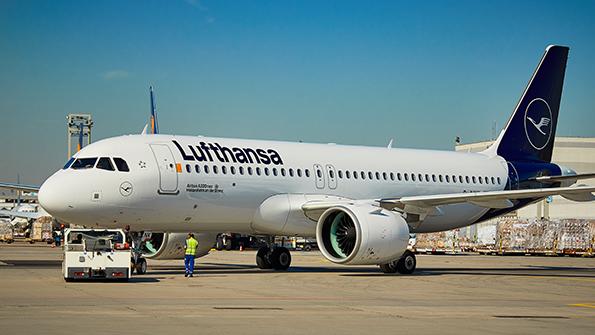Pratt GTF Repair Plan Jolts Beleaguered Airline Industry

Lufthansa will have to ground an average of 20 of its A320neos throughout 2024 to accommodate PW1100G repairs.
One way to understand the effect of the shockwaves reverberating from Pratt & Whitney’s worsening geared turbofan engine woes is to look at MTU Aero Engines’ market capitalization. The German engine manufacturer is an 18% partner in the consortium that builds the PW1100G engine powering about 1,350 Airbus A320neo-family aircraft. MTU lost a quarter of its value—about $3 billion—in the two days following a Sept. 11 investor call by Pratt parent RTX outlining needed repairs to 3,000 PW1100G and V2500 engines.
MTU’s experience is symbolic because the Munich-based company is not directly responsible for its worst devaluation since it started trading as a public company nearly two decades ago. And it has plenty of company. The aftershocks are also hitting a good part of the Airbus A320neo operator base, sending airlines such as Wizz Air, IndiGo, Lufthansa, Spirit Airlines and Turkish Airlines scrambling to deal with fallout that will likely ground parts of their fleets through 2026.
- Up to 650 Airbus A320ceo-family aircraft could be grounded in 2024
- MTU seeks ways to cut turnaround times significantly
For Pratt, there are immediate financial consequences. Longer term, it faces the risk of losing further market share on the Neo program to CFM International’s Leap 1A, which already has been selected by more operators. The durability issues that have been hampering the geared turbofan (GTF) for years have also led to a cooling of the Airbus-Pratt relationship. Airbus is known to be seriously considering CFM as a second engine provider for the A220 program if, as expected, it launches a stretched A220-500 (or A221).
In its Sept. 11 update, RTX revealed the extent of the issue by defining a “fleet management plan.” The plan is complicated, but can be put succinctly: It’s bad.
Some 3,000 engines, including PW1000Gs of all types and IAE V2500s, built from mid-2015 through mid-2021, may have parts with contaminated powder metal (PM). Cracking from PM contamination has been found in high-pressure turbine (HPT) Stage 1 and 2 disks, or hubs, installed in the powerplants. Pratt is also inspecting some high-pressure compressor (HPC) disks built at the same time, RTX revealed. Most of the affected engines are PW1100Gs found on A320neo-family aircraft.
Clogged engine overhaul shops and a fast-tracking of necessary inspections on higher-time PW1100G GTFs will likely drive repair turnaround times to up to as many as 300 days per engine and could ground 650 Airbus A320neos at one time early next year, RTX disclosed. According to Aviation Week Network’s Fleet Discovery database, 1,354 Pratt-powered A320neo-family aircraft are currently in service, parked, stored or in parked/reserve status.
Fleet groundings will “average” 350 at any given time through 2026, according to RTX President and Chief Operating Officer Chris Calio.
The effect on airline operations will be profound. Lufthansa CEO Carsten Spohr, who was in Washington for the U.S. Chamber of Commerce Aerospace Summit in mid-September, used the opportunity to express his annoyance at the news, which caught most operators by surprise.
For Lufthansa, the accelerated GTF removals are expected to result in the grounding of 20 of its A320neos at “any given time next year,” Spohr said. In addition to extending the operation of existing Airbus A320ceo aircraft to offset grounded Neos, the carrier projects it will need to wet-lease an additional 40-50 aircraft next summer.
The PW1100G repairs hit an already stressed airline industry. “It used to be difficult to be a salesperson, and it used to be easy to be a procurement manager—now it’s the other way around,” Spohr quipped. “The supply side is a huge mess. . . . We could sell a lot more seats if there were more aircraft available.”
The same is true for Wizz Air, which has 49 affected aircraft and is slated to cut its planned capacity by 10% in the second half of 2024. Air New Zealand, which counts 16 A320/321neos in its fleet of 106 aircraft, is expecting that reduced engine availability will have a “significant impact” on its schedule starting in January.
IndiGo is the worst affected. The Indian low-cost carrier has 136 Neos built during the critical period. About 50 are already on the ground due to existing durability issues. The airline is urgently seeking as many A320ceos as possible on the secondhand market to battle further capacity shortfalls.
Affected airlines are also bristling over Airbus’ insistence that Pratt continue to deliver new PW1000G engines to its final assembly lines at the contractually agreed flow so that it can proceed with a planned production A320neo ramp-up. That leaves Pratt with scant room to come to the aid of airlines with large numbers of parked aircraft.
Calio confirmed the company has no plans to divert spare engines from its pool of planned deliveries to Airbus. If more spare engines become available, it will be from an overall boost in PW1100G output, he suggested. “The best thing that we can do to help operators is continue to produce the spare engines that are in the plan and try to ramp that to the extent that we can, but [also] drive the industrial ramp needed for maintenance, repair and overhaul (MRO) output,” he said.
In a Sept. 12 note to investors, Melius Research analysts said Airbus is well-protected financially. “If Pratt can’t meet its commitments to Airbus, it will likely owe Airbus compensation,” they wrote.
Financial analysts say it remains to be seen how big of a hit RTX will ultimately take. The company holds a 51% share in the GTF program. It is the largest aerospace and defense provider by annual sales, has cut $1.5 billion from its 2025 free cash flow projection, but still expects to achieve $4.3 billion free cash flow this year in the end.
Just $600 million or so is seen coming from the cost of inspections and rework. The rest, roughly 80% of the total charges, is to compensate aircraft operators for time lost to shop visits. But they may not be the only ones seeking payback. “We think the GTF risk-sharing partners are likely to push back on RTX’s request for partners to cover 49% of the cost of this issue,” the Melius analysts noted.
MTU is one of those partners. It expects profits and revenues to fall by $1 billion this year because of the issue. The company said it “will initiate measures with the aim of limiting the aforementioned effects as far as possible.” More than 30% of commercial aircraft are equipped with technology from MTU, which manufactures aircraft engine components, assembles engines and provides MRO services.
In July, Pratt had announced that previous PW1100G parts inspection intervals, developed after the problem was first uncovered in 2020, were not aggressive enough to flag cracks that the contamination can cause. It said as many as 1,200 engines would need to be pulled in the next year, including up to 200 by Oct. 1. Some of the checks would overlap with scheduled shop visits, reducing unplanned disruptions and costs.
The revised figures now lower the number of engines that need immediate attention but narrow the removal window. The result is higher costs for Pratt and its PW1000G partners as its already full overhaul network faces a wave of engines that require extensive work scopes.
“Since our call in July, we’ve now developed a holistic fleet-management plan that ensures the continued safe operation of the fleet while balancing the impact to our customers,” RTX’s Calio said.
Under the plan, Pratt will pull 600-700 engines in the next two years in addition to about 500 already scheduled for overhauls. Most of the accelerated removals will come by “early 2024,” Calio said. This includes 137 that must be pulled by the end of September. Problem parts in this batch have never undergone a more extensive inspection that Pratt developed to help flag PM “inclusions,” now used on both new parts and those coming in for inspections.
Pratt is developing service bulletins that outline the plan. Its most recent bulletin, calling for the highest-risk engines to be pulled from service this month, was mandated by the FAA and other regulators. Some engines are slated to undergo more extensive overhauls than normally called for, including replacement of both HPT and HPC disks. This will contribute to extended turnaround times.
“It makes sense to replace the compressor disk at the same time,” Calio said. “This is why the work scopes are heavier. It will ultimately give the engine a longer run and be the least disruptive to the operators in the long term.”
Part availability would determine how many engines get new disks. Both the HPT and HPC disks are now being inspected every 2,800-3,800 cycles, depending on engine thrust ratings. The parts under scrutiny have a new, reduced life limit of 5,000-7,000 cycles.
Pratt was working to add PW1000 overhaul capacity to help address the engine’s durability issues before the severity of the HPT disk problem became clear. It said in April that it had 12 shops globally that could handle PW1000 work and planned to add seven more by 2025. The timelines for opening these new shops are being accelerated where possible to help offset the ramifications of the PM issue.
Aviation Week Fleet Discovery shows about 260 PW1500G-powered A220s and PW1900-powered Embraer E2 were built when PM-contaminated disks were produced. About 980 PW1100G-powered A320neos were built, as well as 450 V2500-powered A320ceo-family aircraft. Pratt has a plan in place for the V2500-powered fleet and is confident it is sufficient to detect any issues.




Comments